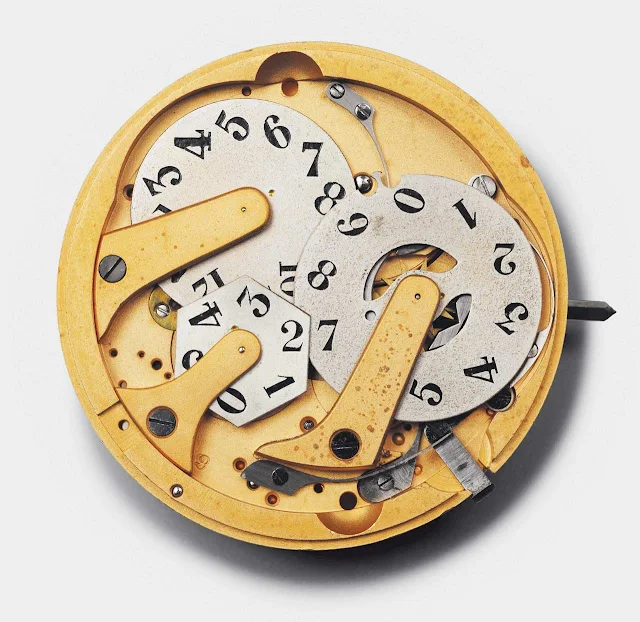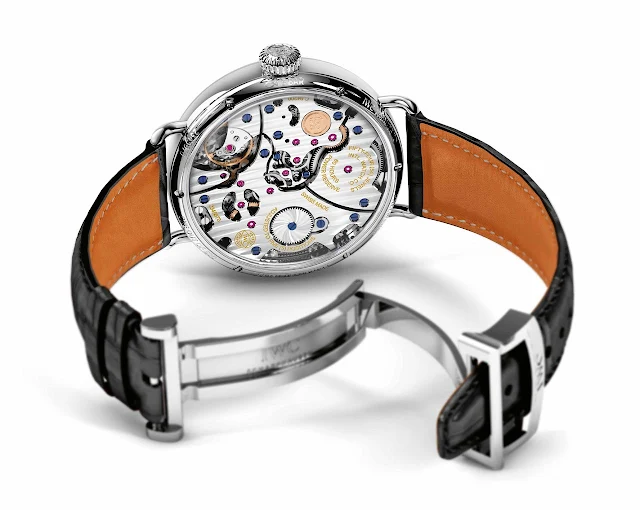SIHH 2018: IWC Tribute to Pallweber Edition “150 Years”. At the Salon International de la Haute Horlogerie 2018 IWC unveiled the Jubilee Collection created to celebrate the important milestone of 150 years of history. Among the 27 limited-edition models, IWC also launched three limited-edition IWC Tribute to Pallweber wristwatches with jumping numerals. A total of 775 watches will be produced and more precisely 25 pieces in platinum (ref. IW505001) with a price of Euro 60,000, 250 in 18-carat red gold with a price of Euro 38,000, and 500 in stainless steel (ref. IW505003) at Euro 24,000.
Following the preview of last December, at the Salon International de la Haute Horlogerie 2018 (Geneva, January 15-19) IWC fully unveiled the Jubilee Collection created to celebrate the important milestone of 150 years of history.
Among the 27 limited-edition models from the Portugieser, Portofino, Pilot’s Watches and Da Vinci families, IWC also launched three limited-edition Tribute to Pallweber wristwatches with jumping numerals.
This is the first time that the Schaffhausen brand incorporates a digital hours and minutes display in a wristwatch. IWC started using this form of time display in pocket watches back in 1884 after securing the rights to the display system developed by the Salzburg watchmaker Joseph Pallweber.
Pretty revolutionary at the time, the historic Pallweber pocket watches showed the hours and minutes in large numerals on rotating discs.
Yet the innovative time display was ahead of its age: the watches were only a commercial success for a brief period before disappearing from the scene after a few years.
As a reference to the design of the historic Pallweber watches and a tribute to F. A. Jones – the American watchmaker who founded IWC – the windows of the digital display are labelled as “Hours” and “Minutes”.
A total of 775 watches will be produced and, more precisely, 25 pieces in platinum with white dial with lacquered finish, blue display discs, blued seconds hand (ref. IW505001), 250 in 18-carat red gold with white dial with lacquered finish, white display discs, blued seconds hand (ref. IW505002), and 500 in stainless steel with blue dial with lacquered finish, white display discs, rhodium plated seconds hand (ref. IW505003). Prices are Euro 60,000, Euro 38,000 and Euro 24,000, in the order described.
Housed in the 45 mm case, the IWC-manufactured 94200 calibre beats at 28,800 vibrations per hour and guarantees a power reserve of 60 hours.
When creating this movement, the watch designers developed a new solution for the technically sophisticated digital display (patent pending). While toothed cogs moved the discs in the historic Pallweber pocket watches, the impulse that advances the single-minute disc is now supplied by a separate wheel train with a barrel of its own. A release mechanism that establishes a connection to the watch’s main wheel train unlocks the train every 60 seconds and then immediately locks it again.
After 10 minutes, the single-minute disc moves the 10-minute disc forward by one position. Every 60th minute, the hour ring jumps to the next numeral. The fact that the flow of power in the main wheel train is uninfluenced by the separate wheel train in the display discs guarantees a precise rate and a high 60-hour power reserve.
Just like on the historic Pallweber pocket watches, the display discs are connected by a mechanical linkage with a star wheel (Maltese cross drive) and can be easily moved forwards or backwards using the crown.
Beautifully finished and enriched by a Jubilee medallion in 18-carat gold, the movement is visible through the sapphire-glass case back. iwc.com
Among the 27 limited-edition models from the Portugieser, Portofino, Pilot’s Watches and Da Vinci families, IWC also launched three limited-edition Tribute to Pallweber wristwatches with jumping numerals.
This is the first time that the Schaffhausen brand incorporates a digital hours and minutes display in a wristwatch. IWC started using this form of time display in pocket watches back in 1884 after securing the rights to the display system developed by the Salzburg watchmaker Joseph Pallweber.
A Pallweber savonnette pocket watch by the International Watch Company dating back to 1886
Pretty revolutionary at the time, the historic Pallweber pocket watches showed the hours and minutes in large numerals on rotating discs.
Yet the innovative time display was ahead of its age: the watches were only a commercial success for a brief period before disappearing from the scene after a few years.
Pallweber pocket watches from the 19th century
As a reference to the design of the historic Pallweber watches and a tribute to F. A. Jones – the American watchmaker who founded IWC – the windows of the digital display are labelled as “Hours” and “Minutes”.
A total of 775 watches will be produced and, more precisely, 25 pieces in platinum with white dial with lacquered finish, blue display discs, blued seconds hand (ref. IW505001), 250 in 18-carat red gold with white dial with lacquered finish, white display discs, blued seconds hand (ref. IW505002), and 500 in stainless steel with blue dial with lacquered finish, white display discs, rhodium plated seconds hand (ref. IW505003). Prices are Euro 60,000, Euro 38,000 and Euro 24,000, in the order described.
When creating this movement, the watch designers developed a new solution for the technically sophisticated digital display (patent pending). While toothed cogs moved the discs in the historic Pallweber pocket watches, the impulse that advances the single-minute disc is now supplied by a separate wheel train with a barrel of its own. A release mechanism that establishes a connection to the watch’s main wheel train unlocks the train every 60 seconds and then immediately locks it again.
After 10 minutes, the single-minute disc moves the 10-minute disc forward by one position. Every 60th minute, the hour ring jumps to the next numeral. The fact that the flow of power in the main wheel train is uninfluenced by the separate wheel train in the display discs guarantees a precise rate and a high 60-hour power reserve.
Just like on the historic Pallweber pocket watches, the display discs are connected by a mechanical linkage with a star wheel (Maltese cross drive) and can be easily moved forwards or backwards using the crown.
Beautifully finished and enriched by a Jubilee medallion in 18-carat gold, the movement is visible through the sapphire-glass case back. iwc.com






















It looks nice on the wrist although 45 mm are a lot for an average wrist like mine.
ReplyDelete